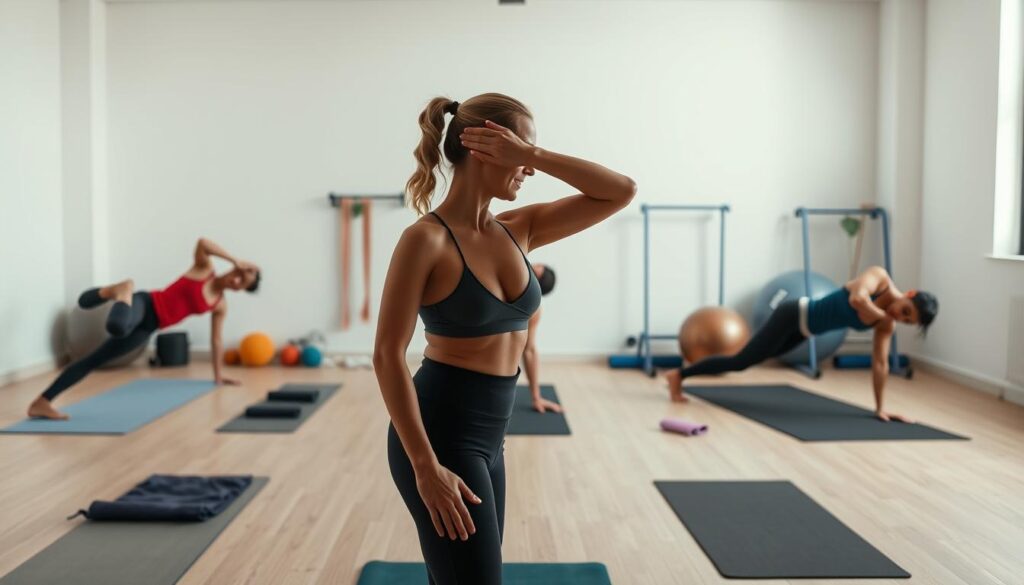Have you ever noticed how your body feels after a long day of sitting or slouching? That ache in your lower back or the tension in your shoulders isn’t just discomfort—it’s your body’s way of telling you something’s off. I’ve been there, and I know how it feels to struggle with maintaining good posture throughout the day.
Proper alignment isn’t just about looking confident; it’s about supporting your overall health. When your body is aligned, it reduces stress on muscles and ligaments, preventing pain and injury. Over time, consistent practice of targeted exercises can transform the way you move and feel.
But it’s not just physical benefits. Standing tall can boost your mood and energy levels, helping you feel more positive and focused. Whether it’s yoga, stretching, or strength-building routines, small changes can make a big difference. Let’s explore how you can take control of your posture and feel your best every day.
Key Takeaways
- Proper alignment supports overall health and reduces muscle pain.
- Good posture contributes to strength, flexibility, and balance.
- Targeted workouts can prevent injury and alleviate stress on muscles.
- Upright posture improves mood and decreases negative self-focus.
- Consistent practice of yoga and back-strengthening routines can enhance posture.
Understanding the Importance of Good Posture
The way you hold your body impacts more than just your appearance. It plays a crucial role in your overall health, from reducing muscle strain to supporting your spine. When your body is in the right position, it works more efficiently, preventing discomfort and injury.
⏳ Get Your Energy Back with Discount!

Physical Benefits and Spinal Health
Proper alignment keeps your spine healthy and reduces stress on your back. Studies show that slouching can lead to neck, shoulder, and back pain in many adults. By maintaining good posture, you can prevent these issues and improve your flexibility by up to 25%.
Your muscles also benefit. When your body is aligned, they don’t have to work as hard to keep you upright. This reduces fatigue and helps you move more efficiently. For example, keeping your arms relaxed and shoulders back can prevent unnecessary strain.
Mental and Emotional Well-being
Good posture isn’t just about physical health—it boosts your mood too. Research shows that standing tall can increase energy levels and reduce negative self-focus. When your body feels good, your mind follows.
Maintaining proper alignment also supports better breathing, which can reduce stress and improve focus. It’s a small change that can make a big difference in how you feel every day.
Identifying Common Posture Problems
Many of us unknowingly develop habits that harm our body alignment over time. These habits can lead to discomfort, pain, and long-term issues if not addressed. Recognizing the signs of poor alignment is the first step toward making positive changes.
🌟 Boost Your Well-Being Today!

Recognizing Signs of Poor Alignment
One of the most common signs is forward head placement. This happens when your head juts forward, increasing stress on your neck and spine. Rounded shoulders and an arched lower back are also telltale indicators.
Tight chest muscles and an uneven hip position can signal misalignment. If you often feel tension in your neck or lower back, it’s worth assessing your posture. Self-assessment is key to catching these issues early.
Lifestyle and Ergonomic Pitfalls
Daily habits play a significant role in posture problems. Sitting for long hours, especially with poor ergonomics, can lead to slumping and misalignment. A poorly set up workspace forces your body into unnatural positions.
Repeated activities like hunching over a phone or computer can worsen these issues. Even tight calf muscles can affect your alignment, pulling your hips out of position. Small changes in your routine can make a big difference.
Ignoring these signs can lead to chronic pain and increased risk of injury. By identifying and addressing these problems, you can take the first step toward better alignment and overall health.
How to improve posture with exercise
Correcting alignment starts with understanding the role of targeted movements. These exercises focus on specific muscle groups to restore balance and reduce discomfort. By incorporating stretches and strengthening routines, you can address common issues like tightness and misalignment.

An Overview of Targeted Movements
Targeted movements are designed to counteract the effects of prolonged poor alignment. For example, stretching techniques that involve the hands and foots can improve flexibility and reduce tension. These exercises often focus on symmetry, ensuring both sides of the body are equally strengthened.
Movements like the Cat-Cow Stretch or Shoulder Blade Squeeze can relieve pain and improve flexibility. Each exercise emphasizes proper alignment, helping to engage the legs, sides, and core muscles. Consistency is key to seeing long-term results.
By focusing on these foundational movements, you can build a strong base for more advanced workouts. Whether it’s holding a stretch for 30 seconds or performing 15 repetitions, these exercises are designed to enhance body awareness and stability.
Effective Posture-Improving Workouts
Taking control of your alignment starts with simple, effective workouts. These routines focus on flexibility, strength, and balance, helping you counteract the effects of bad posture. Whether you’re new to fitness or looking to refine your routine, these exercises can make a big difference.

Yoga and Stretching Routines for Flexibility
Yoga and stretching are excellent for improving flexibility and relieving tension. Movements like Child’s Pose and Forward Fold target the lower back and shoulders, areas often affected by poor alignment. These poses encourage deep breathing, which helps stack the shoulders over the pelvis.
Dynamic stretches, such as the Cat-Cow Stretch, improve spinal mobility. Isometric holds, like the Plank, build endurance in the core muscles. Consistency over time is key to seeing results. Even a few minutes daily can yield significant improvements.
Core and Back Strengthening Exercises
Building strength in your core and back is essential for proper alignment. Exercises like the Bird Dog and Shoulder Blade Squeeze engage the muscles that support your spine. These movements help counteract the effects of prolonged sitting and slouching.
Focus on symmetry to ensure both sides of your body are equally strengthened. For example, place your palms flat on the floor during planks to distribute weight evenly. Over time, these exercises will enhance your body awareness and stability.
“Small, consistent efforts lead to lasting changes in how you move and feel.”
Integrating these workouts into your routine doesn’t require hours at the gym. Short, focused sessions can help you build strength and flexibility while reducing the impact of bad posture. Start today and take the first step toward better alignment.
Integrating Posture Exercises into Your Daily Routine
Small changes in your daily habits can make a big difference in how you feel and move. Incorporating simple exercises into your routine helps maintain alignment and reduces stress on your muscles. Whether you’re at the office or home, these quick moves are easy to fit into even the busiest days.
Quick Moves for the Office and Home
Start by checking your alignment throughout the day. Sit with your elbows at a 90-degree angle and your feet flat on the floor. This position helps distribute your weight evenly and reduces strain on your back.
Take short breaks to stretch. Stand up, bend your knees slightly, and reach your arms overhead. This simple move counteracts the effects of prolonged sitting and keeps your muscles engaged.
Use ergonomic aids like lumbar supports or adjustable chairs. These tools encourage proper posture and make it easier to maintain alignment. Self-monitoring techniques, like setting reminders to sit up straight, can also help.
Periodic movement breaks are essential. Every hour, take a minute to lie down or perform a quick stretch. These small actions prevent slouching and keep your body in balance.
Integrating these exercises into your routine is both easy and effective. Over time, they support long-term improvements in how you move and feel. Start today and take the first step toward better alignment.
Enhancing Posture with Ergonomic Adjustments
Creating a workspace that supports your body’s natural alignment can transform your daily experience. Small changes to your environment can reduce muscle tension and promote better health. By making thoughtful adjustments, you can maintain proper alignment throughout the day.
Optimizing Your Workspace Setup
Start by aligning your chair, desk, and computer screen to foster an ideal line of sight. Your screen should be at eye level to prevent neck strain. Adjust your chair so your feet rest flat on the floor and your elbows form a 90-degree angle.
Using lumbar support cushions can help maintain the natural curve of your spine. Ergonomic tools like adjustable chairs and footrests reduce pressure on your thighs and lower back. These changes mimic the benefits of yoga by promoting flexibility and reducing tension.
Incorporating Movement Breaks
Taking short breaks to stretch throughout the day minimizes the negative effects of prolonged sitting. Stand up every 30 minutes and perform simple movements like reaching your arms overhead or bending your knees slightly. These actions counteract slouching and keep your muscles engaged.
Setting reminders for stretching ensures consistency. Even a few minutes of movement can enhance your overall health. Over time, these habits make it easier to sustain a posture-conscious day.
| Adjustment | Benefit |
|---|---|
| Align screen at eye level | Reduces neck strain by 50% |
| Use lumbar support | Decreases lower back strain by 40% |
| Take movement breaks | Improves comfort and productivity by 15% |
These ergonomic adjustments not only enhance your physical well-being but also contribute to a more productive and comfortable day. Start today and take the first step toward better alignment and health.
Additional Tips for Improving Posture and Reducing Pain
Addressing discomfort in your body starts with understanding the root causes of pain. Whether it’s tension in your shoulder back or stiffness in your lower back, targeted strategies can make a significant difference. By focusing on gentle stretches and strengthening exercises, you can alleviate discomfort and support your spine.
Managing Lower Back, Shoulder, and Neck Discomfort
Pain in these areas often stems from poor posture and muscle imbalances. Gentle stretches like the Cat-Cow Pose can relieve tension in the lower back. For the shoulder back, exercises like Shoulder Blade Squeezes help realign muscles and reduce strain.
Strengthening your core is essential for supporting your spine. Movements like Planks engage the abdominal muscles, which play a key role in maintaining alignment. Keeping your knee bent slightly during exercises prevents joint locking and ensures proper form.
Lifestyle adjustments also matter. Take breaks every 30 minutes to stretch and move. Use ergonomic tools like lumbar supports to maintain your spine’s natural curve. These small changes, combined with regular exercise, can lead to lasting improvements.
“Consistent effort in stretching and strengthening can transform how you feel and move.”
By integrating these tips into your routine, you can reduce pain and enhance your overall alignment. Start today and take the first step toward a healthier, more comfortable lifestyle.
Conclusion
Commitment to small, consistent efforts can transform how you move and feel. Integrating stretching, yoga, and strength workouts into your routine supports long-term alignment. Change takes time, but addressing your body holistically—through both movement and ergonomic adjustments—yields the best results.
Improved alignment benefits both physical and mental health. A balanced yoga pose or a simple hand knee stretch can reduce tension and enhance flexibility. These practices not only alleviate discomfort but also boost energy and focus.
Start today by committing to daily habits that prioritize alignment. Whether it’s a quick hand knee stretch or a mindful yoga pose, these small steps lead to lasting improvements. Your body will thank you.








Comment on “How to Improve Your Posture with Exercise: Tips and Workouts”